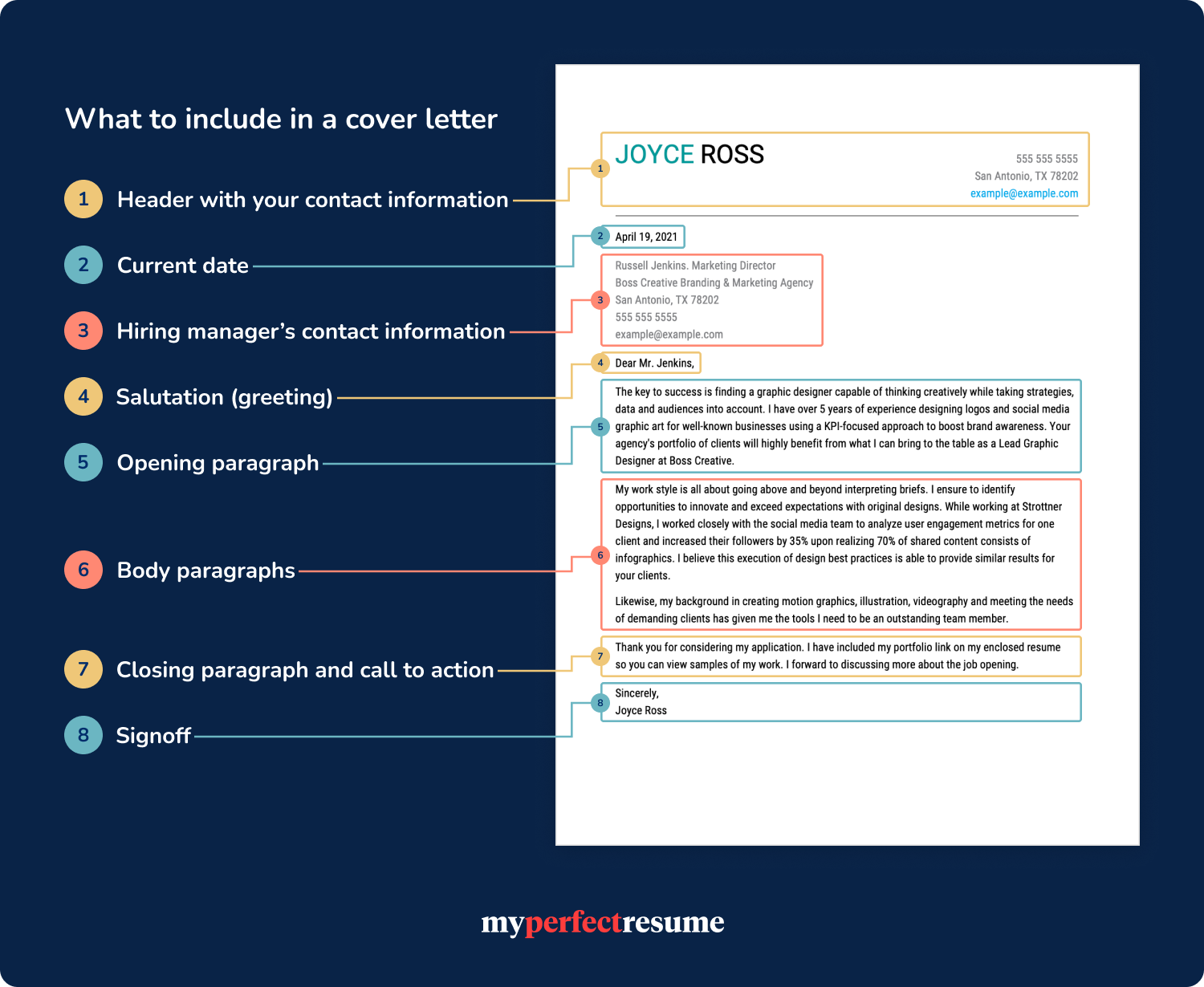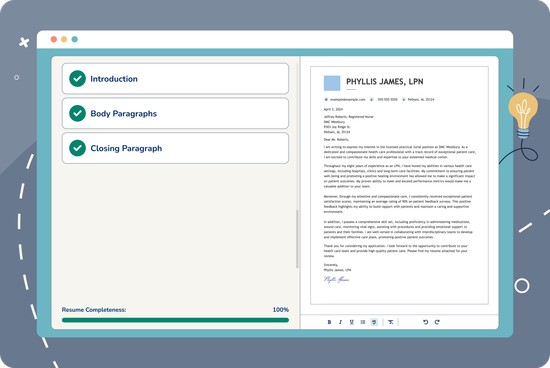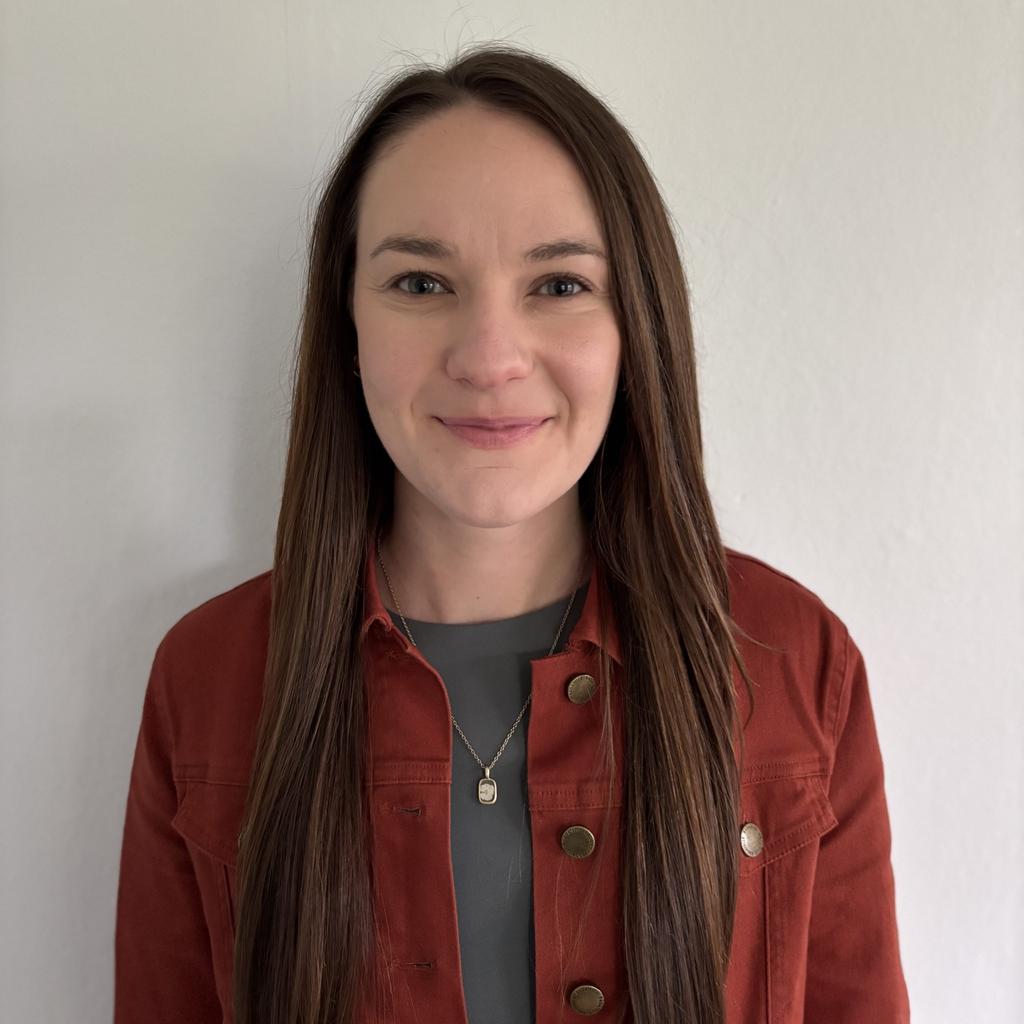Our customers have been hired at: *Foot Note
Pairing your resume with a well-written cover letter can make all the difference in securing an interview and landing your dream job.
In this article, we’ll discuss what to include in a cover letter to make a strong first impression and set yourself apart from the competition. We’ll cover the following topics:
- What to include in a cover letter for a job
- How to include keywords in a cover letter
- What not to include in a cover letter
- Cover letter examples for various roles
- What to include in an email cover letter
Take a look at the infographic below for a quick snapshot of key information to add to your cover letter. We also recommend exploring our library of 200+ cover letter examples for additional inspiration.
Search our extensive collection of 800+ resume samples to understand how to best present your skills and achievements.
What to include in a cover letter for a job
Knowing what to include in a cover letter when applying for a job is essential for making a positive first impression and increasing your chances of landing an interview.
Our Cover Letter Builder takes the guesswork out of writing this essential document. All you have to do is pick a template and click to add ready-made content from Certified Professional Resume Writers.
Whether you’re using a cover letter builder or writing your cover letter from scratch, it’s important to understand what information to include in a cover letter. We’ve detailed each section below so that you can create a job-winning cover letter in no time.
Header with your contact information
It is essential that you include up-to-date contact information in your cover letter so that employers can contact you for a job interview.
In your document's header, add your full name, email address, phone number and physical address (city, state and ZIP code). You can also add your LinkedIn profile or professional website address if you have one.
The placement of your contact details will vary depending on the design of your header. Check out how to format a cover letter for further details and examples.
PRO TIP
Our professionally designed cover letter templates come preformatted with professional headers. All you need to do is pick a design that catches your eye and add your contact details.
The current date
Add the current date below your contact information. Remember to change the date if you update your cover letter in the future for a new role.
If you spend a few days writing your cover letter, remember to update the date when you are finished to reflect the date that you submit your application.
According to a survey of 234 employers published in “Business Communication Quarterly,” 56% of the surveyed employers prefer applicants who include a cover letter with their resume.
The hiring manager’s contact information
Next, add the hiring manager’s name (if you have it) and their contact information. Follow the example below:
[Hiring manager’s name], [Hiring manager’s job title]
[Company name]
[Company street address]
[Company city, state and ZIP code]
If the job listing doesn’t indicate who the hiring manager is, we recommend exploring the company’s website or LinkedIn page to find this information.
If your research doesn’t turn up a name, you can omit the name and job title and jump straight to the company name and address.
Salutation (greeting)
Start your cover letter with a professional salutation to greet the recipient. The most widely accepted professional greeting is “Dear [recipient’s name].” Avoid informal salutations such as “Hi,” “Hey” or “Good afternoon.”
If you are not 100% certain of the hiring manager’s gender, you can opt for using their full name instead (i.e., “Dear Jacob Fuller”).
Alternatively, you can address the team or department connected to the role you are applying for. For example, “Dear HR Team” or “Dear [Company Name] Marketing Team.”
Compelling introduction
The opening paragraph of your cover letter needs to be engaging and thoughtful to grab the attention of the hiring manager. Here are a few examples of how to start a cover letter effectively:
- Mention a shared contact: For example, “My colleague, Jane Doe, who previously taught at XYZ School, recommended I apply for this position.”
- Express your interest in the company: For example, “I was immediately drawn to the school's commitment to academic excellence and student success.”
- Lead with a measurable accomplishment: For example, “In my last teaching position, I implemented a project-based learning approach that resulted in a 20% increase in student participation and an 85% pass rate on state assessments.”
- Start with a mission statement: For example, “My teaching philosophy is centered around creating a safe and inclusive classroom environment where all students feel valued and supported.”
Remember to keep your introduction concise and to the point. The length of your cover letter should not exceed one page.
In fact, shorter is better when it comes to writing a cover letter, and a snappy introduction is a great way to engage your reader right off the bat. Check out our guide on basic cover letters for additional tips and tricks.
Body paragraphs detailing your qualifications
Your cover letter should include one or two body paragraphs that describe the qualifications that make you a great fit for the role.
This is your chance to expand on any measurable accomplishments you mentioned in the introduction and to demonstrate how the skills listed on your resume align with the job description.
PRO TIP
When you make a resume with our Resume Builder, you can instantly generate a matching cover letter populated with prewritten content specific to the job titles and skills listed in your resume.
Use the body paragraphs to demonstrate your enthusiasm for the position and the company by mentioning specific aspects that you admire about their culture, products or services.
If there are gaps in your resume or you are changing careers, use the body paragraphs to address any potential concerns the employer may have. Explain how your interpersonal skills and experiences are transferable to the new role.
Closing paragraph and call to action
Your cover letter conclusion should express gratitude to the reader, reiterate your interest in the role and include a clear call to action. Take a look at the example below to get inspired:
In the closing paragraph of your cover letter, it's important to maintain an enthusiastic, confident and professional tone. You want to leave a positive impression on the hiring manager and show them that you are excited about the opportunity to join their team.
Professional signoff
End your cover letter with a professional signoff followed by your name. If you are handing in a physical copy of your cover letter, sign your name with ink. If not, you can use a digital signature or simply type out your full name.
Here are some professional signoffs you can use for a cover letter:
- Sincerely
- Best regards
- Kind regards
- Respectfully
- Thank you
- With appreciation
- Cordially
- Regards
When choosing a signoff for your cover letter, it's important to consider the tone and level of formality of the letter. Avoid using overly casual signoffs like "Cheers" or "Take care" as these can come across as unprofessional. Instead, opt for a signoff that is respectful and professional.
Make a cover letter with MyPerfectResume
Our Cover letter builder can help you write the perfect cover letter. Start Now!
How to include keywords in a cover letter
You’re likely familiar with how to write an ATS-friendly resume, but what about your cover letter? Many employers use applicant tracking systems (ATS) to scan job applications for keywords that are relevant to the role.
Typically, these keywords are skills or job titles that the employer wants to see in the candidate’s application. It’s important to optimize your cover letter for ATS by incorporating keywords that show ATS and hiring managers that you are a great fit for the role.
Here are a few tips on how to include keywords in your cover letter:
- Study the job description: Carefully read the job description and identify the important keywords that are relevant to the job position.
- Use the right keywords: Use the same keywords that are used in the job description. For example, if the job description mentions “strong communication skills” or “project management experience,” include these exact phrases in your cover letter.
- Highlight your relevant skills: Use the keywords to highlight your relevant skills and experience. For example, if the job requires “sales experience,” mention your sales experience and achievements in your cover letter.
- Don’t overuse keywords: While it’s important to use relevant keywords in your cover letter, don’t overuse them. Make sure your cover letter is still readable and flows naturally.
PRO TIP
Use our free ATS resume checker to scan your resume for common errors and receive personalized feedback. Pair your resume with a matching cover letter to land an interview fast.
What to include in the body of your cover letter
When it comes to deciding what to include in the body of your cover letter, the key is to add new information rather than repeating what’s already on your resume.
Here are a few topics to consider including in the body of your cover letter:
- Relevant experience: Write about your relevant work experience that shows you have the skills and knowledge required for the job position. Mention specific accomplishments and projects that demonstrate your capabilities.
- Education and certifications: If you have relevant education or certifications, mention them in your cover letter. This can show that you have the necessary knowledge and skills to perform the job.
- Transferable skills: If you are switching careers or have experience in a different field, highlight your transferable skills. These are skills that can be applied to the job position, even if they were gained in a different industry.
- Industry knowledge: If you have knowledge of the industry or the company, mention it in your cover letter. This shows that you have done your research and are genuinely interested in the job opportunity.
Keep in mind that your cover letter is your chance to gain a competitive edge by detailing the unique value you can bring to the company.
Be explicit in discussing how your qualifications, professional accomplishments and relevant skills make you a great fit for the role.
What not to include in a cover letter
Knowing what you shouldn’t include in a professional cover letter is just as important as knowing what you should include. Here are a few things you should avoid including in your cover letter:
- Personal information Your cover letter should focus on your professional qualifications and experience. Avoid including personal information such as your age, marital status or hobbies that do not relate to the job.
- Salary expectations While it's important to know your worth and what salary range you're looking for, your cover letter is not the place to discuss this. Save this conversation for later in the hiring process.
- Negative comments about a previous employer Criticizing previous employers or colleagues reflects poorly on you and can make you seem difficult to work with. Instead, focus on the positive experiences and lessons you've learned.
- Irrelevant information Stick to the job requirements and the skills and experience you have that make you a good fit for the position. Avoid including irrelevant information that doesn't add value to your application.
- Clichés and generic statements Avoid using overused phrases and vague statements that don't tell the hiring manager anything specific about you or your skills. Be specific and provide examples of your accomplishments and how they relate to the job you're applying for.
Examples of what to include in a cover letter for different jobs
From internships to full-time jobs, we’ve got you covered with professionally made cover letter examples for a variety of roles and industries.
What to include in an email cover letter
In today’s digital world, handing in a paper cover letter is a thing of the past. According to a survey conducted by “Business Communication Quarterly,” most employers prefer to receive cover letters via electronic delivery.
The vast majority of employers prefer electronic delivery, either by email (46%) or at the company's website (38%), with only 7% preferring a paper copy.- Nancy M. Schullery, Linda Ickes and Stephen E. Schullery
With email prevailing as the preferred method of delivery for cover letters, it’s important to understand what to include in an email cover letter.
Download your completed cover letter and resume and include them as attachments in the email you send to the hiring manager. Take a look at the template below for an idea of what to include in the body of your email:
Subject line: Job Application: [Position Title] - [Your Name]
Dear [Hiring Manager’s Name],
I am writing to express my interest in the [Position Title] role that I came across on [where you found the job posting]. I have attached my resume and cover letter for your consideration.
With [Number of years] years of experience in [Field/Industry], I have developed a diverse skill set that I believe would be a valuable asset to your company. In my current role at [Current Company], I have honed my skills in [skill or responsibility relevant to the job you’re applying for]. I am excited about the opportunity to bring my expertise and passion for [related skills or industry] to your team at [Company Name].
Thank you for considering my application. I would be happy to discuss my qualifications further and I look forward to hearing from you.
Sincerely,
[Your Name]
Remember to keep the body of the email succinct and to mention that your cover letter and resume are attached.
What to include in a resume cover letter key takeaways
- Including the right information in your cover letter is essential for impressing hiring managers and securing an interview.
- Use the standard business format for the header of your cover letter and remember to include relevant contact information. Grab the recipient’s attention with a compelling introduction.
- Detail measurable accomplishments in the body paragraphs of your cover letter, and refrain from repeating exactly what’s on your resume.
- Include keywords from the job description throughout your cover letter to ensure your resume makes it past ATS and into the hands of hiring managers.
- Include a thoughtful closing paragraph and professional signoff to make a good impression.
- Don't include overly personal information, negative comments about past employers or vague and irrelevant information in your cover letter.
What to put in a cover letter for a job FAQ
How do you begin a cover letter?
Determining what to include in a job cover letter opening paragraph can be tricky. The beginning of your cover letter is the first impression that the hiring manager will have of you, so it’s important to start off strong.
Start with a strong opening sentence that grabs the hiring manager’s attention. This could be a statement about your qualifications, a question or a relevant quote.
Here’s an example of a strong opening for a cover letter:
Dear [Hiring Manager’s Name],
I was excited to see the [Job Position] opening on your website and am eager to apply for the role. As a [Your Qualifications], I believe I would be an asset to your team and contribute to the success of your company.
Is it necessary to have a cover letter?
While a cover letter is not always required, it is highly recommended to include one with your job application. A cover letter allows you to introduce yourself to the hiring manager, highlight your qualifications and skills and explain why you are interested in the position.
In addition, a cover letter can provide more information about your qualifications and experience that may not be included in your resume. It allows you to go into more detail about your accomplishments and how they relate to the job position.
This can help the hiring manager understand why you are a good fit for the job and what you can bring to the company. It also provides the opportunity to showcase high-income skills employers seek, such as project management and sales.
Explore our guide to learn what is important to include in a cover letter to impress hiring managers and increase your chances of landing an interview.
What do you need to include in a cover letter?
Your cover letter is an essential part of your job application. However, without a clear idea of what to put in it, it’s common to be left wondering, “What do I need to include in a cover letter?”
Here is the essential information to include in your cover letter:
- Contact information (name, address, phone number and email address).
- Current date when you submit your job application.
- Employer’s contact information (if you have it).
- Salutation addressing the hiring manager by name.
- A strong opening sentence that grabs the hiring manager’s attention.
- Qualifications, skills and experience that make you a strong candidate.
- Closing paragraph thanking the hiring manager for considering your application.
- Professional signoff such as “Sincerely” or “Best regards,” followed by your name and a signature.
We recommend using an AI cover letter generator to quickly and easily make a cover letter that includes all of the information that hiring managers want to see. Check out our ChatGPT cover letter guide for more tips and tricks.
How do you write a cover letter that stands out?
Wondering what to include in a cover letter for a resume to stand out from the competition? The key is to tailor your cover letter to each job you apply for.
In the same way that a targeted resume demonstrates that you’ve done your research, a tailored cover letter shows your genuine interest in the role. Here’s what to include in a good cover letter that stands out to employers:
- Highlight relevant accomplishments: Use specific examples and details to highlight your accomplishments and how they relate to the job position.
- Show your enthusiasm: Express your enthusiasm for the job position and the company. Let the hiring manager know why you are interested in the job and what you can contribute to the company.
- Use keywords: Use keywords from the job description in your cover letter to show that you are a good fit for the job. This can help your cover letter get past applicant tracking systems (ATS) used by some companies.
Also include relevant cognitive skills such as critical thinking or data analysis to stand out. Overall, a well-written and tailored cover letter can help you stand out from other applicants and increase your chances of getting an interview.
Should you include volunteer work in a cover letter?
Including volunteer work in a cover letter can be a good idea if it is relevant to the job position you are applying for. Here are some tips for including volunteer work in your cover letter:
- Choose relevant volunteer work: If you have volunteer experience that is relevant to the job position, include it in your cover letter. Use action verbs to describe key accomplishments and responsibilities.
- Highlight transferable skills: Even if your volunteer work is not directly related to the job position, you can highlight the transferable skills you gained through your volunteer work. For example, if you volunteered at a food bank, you can highlight your organizational and communication skills.
- Keep it brief: Your cover letter should be concise, so keep your discussion of volunteer work brief. Mention it briefly in the body of your letter, and focus on how it demonstrates your skills and qualifications.
- Emphasize the impact: Highlight the impact you made through your volunteer work. Describe how you contributed to the organization and the difference you made through your work.
Overall, including volunteer work in your cover letter can be a good way to demonstrate your skills and commitment to the job position. See our guide on the necessity of cover letters for additional tips and examples from career experts.
How we reviewed this article
Since 2012, we have helped more than 11 million job seekers. We want to make your career journey accessible and manageable through our services and Career Center’s how-to guides and tips. In our commitment to bring you a transparent process, we present our Editorial Process.
Sources
- Harvard Business Review. Article. Gallo, Amy. How to Write a Cover Letter
- SageJournals. Business Communication Quarterly. Schullery, N. M., Ickes, L., & Schullery, S. E. Employer Preferences for Résumés and Cover Letters
- The Balance. Blog. Doyle, Alison. What to Include in a Cover Letter for a Job
- Columbia University Center for Career Education. Article. How and Why to Write a Great Cover Letter
- The Wall Street Journal. Article. Pohle, Allison. How to Write a Cover Letter That Stands Out
- University of Wisconsin-Madison. The Writing Center. Article. Writing Cover Letters
Our customers have been hired at:*Foot Note




